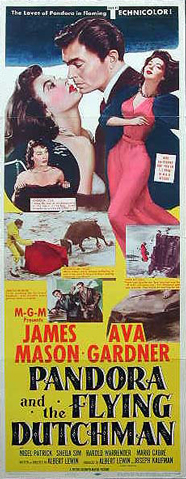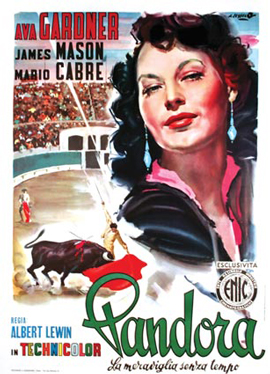
 |
|
|
|
Producer Albert Lewin turned to writing and directing in the 1940s and soon became a cinematic darling of the intellectual set. Lewin's adaptations of respected novels often starred George Sanders, whose sly, sardonic temperament lent itself to the cruel, obsessed painter Charles Strickland in Somerset Maugham's The Moon and Sixpence and the decadent Lord Wotton in The Picture of Dorian Gray. Lewin favored period stories involving unlikeable people in high society. His The Private Affairs of Bel-Ami starred George Sanders as a consummate cad who uses women to improve his social station. Critics looking for literary merit praised Lewin for raising the level of Hollywood sophistication. One of the few dissenters was James Agee, who found The Picture of Dorian Gray dramatically inert, and cited Lewin's over-reliance on direct dialogue quotes from the source book. Sanders recites Lord Wotton's eloquent, acid remarks with great skill, but the movie only occasionally comes to life. The Moon and Sixpence and Dorian Gray, both B&W films, utilized brief Technicolor snippets for a visual jolt. Both instances involve artwork -- Strickland's burning paintings and Dorian Gray's portrait of horror. In 1951 Albert Lewin produced, wrote and directed the fully Technicolored Pandora and the Flying Dutchman, starring Ava Gardner and James Mason. The story is ideal Albert Lewin material, a classic tale with roots in folklore and high culture. The movie was released by MGM but eventually reverted back to its producers and became difficult to see in quality presentations. TV presentations and video copies never captured the film's radiant colors. Kino International released a DVD ten years ago, sourced from a Technicolor print. Good transfers are almost always made from low-contrast positive or negative film elements, as dense Technicolor prints tend to yield poor results. But with the help of Martin Scorsese's Film Foundation and The George Eastman House Kino has remastered Lewin's romantic fantasy, enabling viewers to enjoy the film's beautiful stars in a much-improved presentation. The original Flying Dutchman legend actually refers to a fabled vessel that, lost in treacherous straits, reappears as a ghost ship and is sighted by other ships in distress. Wagner's operatic adaptation added a romantic angle: the ghost of a cursed sea captain must sail the seas for eternity, until he finds a woman willing to redeem him with her life. 
Lewin sets this core amour fou concept among a group of wealthy English visitors to the East coast of Spain around 1930. American playgirl Pandora Reynolds (Ava Gardner) attracts three ardent suitors. The foolish Reggie (Marius Goring) throws his life away because he cannot possess her. Ignoring the romantic pleas of Janet (Sheila Sim), racing car driver Stephen Cameron (Nigel Patrick) bargains his way into an engagement with the seemingly aloof Pandora. Impossibly haughty matador Juan Montalvo (Mario Cabré) is willing to commit murder to make Pandora his own. But Pandora is drawn to a mysterious Dutchman, Hendrik van der Zee (James Mason). She finds the moody painter on a yacht moored off the beach. Hendrik explains nothing about himself. Pandora seems to intuit that she's destined to be with this strange man. Albert Lewin's wordy screenplay is a tangle of romantic notions about Eros and death that does the female sex no favors. Pandora Reynolds is neither a vamp nor an innocent femme fatale like Lulu of Pabst's Pandora's Box, and she cannot be held liable because three foolish men go to extremes to prove their love to her. But she does luxuriate in her power over Stephen, who tries to bargain for her love by willingly destroying his racing car. And we sympathize with Janet, whose conventional love for Stephen can't compete with the glamorous Pandora. Lewin's tale may be a critique of the traditional representation of sexually powerful women as dangerous and unnatural. Pandora and the Flying Dutchman certainly paints the fable in attractive colors. The film's evocative images are supplied by ace Technicolor cameraman Jack Cardiff, just a couple of years after his astonishing color work for Michael Powell and Emeric Pressburger on Black Narcissus and The Red Shoes. Cardiff's location know-how results in impressive shots of the broad beach and a speed trial with Stephen's vintage automobile. One clever effect shot manages an impressive pullback through a bell tower. The exotic Mediterranean provides a lengthy bullfight sequence and a shorter exhibition of authentic gypsy flamenco, both beautifully photographed in Technicolor. The film presents indisputably gorgeous images of Ava Gardner and James Mason, two of the most attractive stars of 1951. Cardiff's hypnotic close-ups of Ms. Gardner are almost too luscious to be real. Although the Production Code dictates that Pandora Reynolds be a chaste playgirl, she's afforded an erotic nude swim to Hendrick's yacht, and appears before him wrapped in a piece of sail cloth. Hendrick is absorbed in his latest artwork, a portrait that unaccountably resembles Pandora, whom he has never seen before. 
The extended flashback explaining the 200 year-old curse on the Flying Dutchman showcases James Mason's despairing, rage-filled speech, in which he defies God and the Cosmos to punish him without mercy. Designer John Bryan's period décor uses ornate parquet floors to create a subtle surreal effect - Mason appears isolated in Escher-like patterns. Lewin's attempt at stylization for a pre- jet set midnight beach party sequence isn't as successful. Decadent rich folk dance among Grecian columns and marble statues, and the forced surreal compositions cross the line into Kitsch. The fault in Pandora and the Flying Dutchman lies between its glossy visuals and Albert Lewin's literary instincts. Much of the story is told through the experience of the worldly-wise antiquities professor Geoffrey Fielding (Harold Warrender), whose narration puts an unwanted distance between us and the ill-fated lovers. Fielding's observations are barely worthy of a fortune cookie: "To understand a single human heart is like emptying the ocean with a spoon." Lewin insists on having his characters articulate what should have remained subtext: "The measure of love is what one is willing to give up for it." When Pandora and Hendrick van der Zee finally face their destiny in a rising storm, they take turns reciting poetic speeches about love beyond space and time. A little of this wordy delirium goes a long way, a lesson Lewin should have learned from David O. Selznick's Portrait of Jennie. Fortunately, the powerful star chemistry between Gardner and Mason retains our interest. Kino International's Blu-ray of Pandora and the Flying Dutchman is a fine presentation of this favorite romantic fantasy. The video restoration did not extend to erasing tiny emulsion digs and built-in white specks, so the transfer hasn't the spotless look of recent Criterion discs with much higher budgets. Colors and contrast have been boosted for Kino's HD transfer. I don't remember original Technicolor prints having the intense quality I remember from other Technicolor films -- much of the movie has been given a bluish dusk-for-night effect -- but with the exception of a couple of shots here and there the transfer is fine. Kino's extras begin with a comparison between this transfer and their older DVD release, which was no beauty. 1 An alternate U.K. opening title sequence is next. One of the three trailers included is "hosted" by Hedda Hopper, who proclaims Ava Gardner the most glamorous movie star of 1951. A group of image galleries contain stills and advertising images. The extras conclude with El Torero de Córdoba a two-reel Spanish documentary from the late 1940s that celebrates the career of the matador Manolete, who died in the bullring. Pandora's "Montalvo" is reportedly modeled after this revered figure. Pandora and the Flying Dutchman was featured in the first TCM Fest at the Chinese Theater in April of 2010. The screening was attended by the film's continuity girl Angela Allen, who also performed similar duties on, among other legendary pictures, The Third Man and The African Queen. The adventurous Ms. Allen recounted how she doubled for Ava Gardner in wide shots showing Pandora swimming to James Mason's yacht. She also explained that when Gardner's fiancé Frank Sinatra paid an unexpected visit to the Spanish location, the crew was forced to hide the actress's latest boyfriend... a bullfighter.
On a scale of Excellent, Good, Fair, and Poor,
Footnotes:
1. That disc came out before I edited the 2001 Jack Cardiff tribute for the Academy Awards show, but the dark image made me give up sampling any shots in the montage.
Reviews on the Savant main site have additional credits information and are often updated and annotated with reader input and graphics. Also, don't forget the 2010 Savant Wish List. T'was Ever Thus.
Review Staff | About DVD Talk | Newsletter Subscribe | Join DVD Talk Forum |
| ||||||||||||||||||